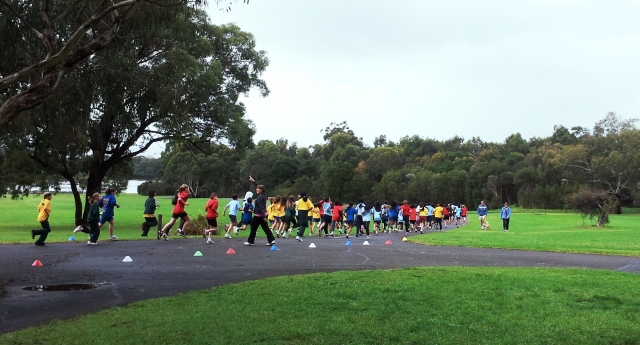Athletics an ‘elite’ sport
The general decline in athletics participation in Australia highlights the gap between “elite” and local levels.
It is a cloudy and cold morning. Despite the drizzle dampening the ground, hundreds of kids scream in encouragement of their teammates who are running a cross-country race in Jells Park.
Madeline’s Café is a familiar meeting point for Phil Hutton and Trevor Vincent. There they have coffee and talk about the club. Mr Hutton walks into the café in his Asics with a big smile on his face. The writing on his blue cap says “Glenhuntly Athletics”. He is the manager of the Juniors in Glenhuntly Athletics, the biggest and most successful athletics club in Victoria. Sipping an English tea, he starts talking.
“Athletics is not attractive anymore,” Mr Hutton says, for a moment losing his contagious good mood.
Looking at the enthusiastic crowd of kids running in the mud, this admission sounds strange. But his glance is serious.
Looking at the national data, it is in fact striking to see a drastic decline in athletics participation; the 15,157 registrations in 2011 contrast the 25,000 in the 1970s. Further still, athletics has seen a seven percent drop in the couple of years leading up to the London 2012 Olympic Games alone.
(Source: Athletics Australia Annual Reports 1999 to 2011)
Furthermore, the lack of cooperation between Little Athletics and Athletics Australia is partly responsible for a “churn rate” – the number of those who leave the sport each year – of around 50%.
Despite reporting such decline in registration throughout its Annual Reports, Athletics Australia has been unwilling to release any comment on the drop.
“The reasons for the decline are easy to determine,” Mr Hutton points out.
Although local clubs run seasonal races in summer and winter, the coverage of these events is considerably poor. Australia only seems interested in athletics at the Olympic and Commonwealth Games. Even still, the percentage of the population that follows the sport – even at “elite” levels – has drastically decreased after the Sydney 2000 Olympic Games.
| Sport | Sydney 2000 | Athens 2004 | Beijing 2008 |
| Swimming | 47% | 47% | 30% |
| Gymnastics | 6% | 8% | 15% |
| Diving | 1% | 6% | 7% |
| Athletics | 18% | 7% | 6% |
| Basketball | 3% | 3% | 4% |
| Cycling | 2% | 4% | 4% |
| Soccer | 2% | 2% | 3% |
(Source: Sweeny Sports 2008 Beijing Olympic Games Report)
“Usually in an Olympic year we see a spike upwards as more media attention is put on our sport but this soon falls away after the games,” Mr Hutton says.
Only local newspapers regularly report athletics races and results, whereas “footy-mania” reigns undisputed over the Australian mainstream media and throughout the community. The interest and the attention paid to the sport at local levels is minor.
“Even when we have elite overseas athletes visit, it gets less coverage than many other sports. We don’t have a Cathy Freeman or other world ranked athlete doing well at the moment to hang our promotion on,” Mr Hutton admits.
Glenhuntly Athletics Club plays a small part, however, in promoting the sport by creating links with the local media, circulating good stories and experiences, and by utilising the networks that current members have with the community.
While local clubs try to beat the negative trend in athletics by improving networks and arrangements with secondary schools and universities, the two national organisations expected to run the sport and develop athletes do not cooperate with one another.
“Juniors programs, promoted by Little Athletics, still provide a wealth of interest for boys and girls as young as six, but by the time they get to 13 very few make the transition to senior athletics…only the very interested continue,” Mr Hutton reports gloomily.
As if these weren’t enough problems, Australian athletics also suffers from little funding. Despite being a time-consuming sport to compete at the top level, there is little financial reward except for the “elite” athletes. Moreover, this strengthens the perception of athletics as an “elite” sport only.
A radiant coach of Glenhuntly Athletics, Lesley Grimes, explains that clubs rely only on membership, on very little sponsorship and on voluntary work predominantly. At the local level, there is simply no money and everything must be done by passionate members.
“That’s why clubs can’t pay coaches,” she says sarcastically.
(Source: Glenhuntly Athletics’ Gallery)
While the bitter cold forces Mr Hutton to wear his raining jacket, Trevor Vincent joins the table and orders a hot cappuccino. Despite being over 70, the energy of the once-Olympic cross-country runner can be felt at arm’s length. He is the soul of Glenhuntly Athletics Club.
His commitment , as manager of the Seniors, is to increase club membership and encourage more people to share the enjoyment of athletics.
“We try to use our contacts and promote the positive aspects of club membership – and we are continually endeavoring to look after our members better,” he says.
Nevertheless, Mr Vincent does not look satisfied. The club’s limited and amateur resources do not provide appropriate or adequate coaching, training and competition opportunities.
“But we are continually trying to do things better,” he says.
Lesley Grimes’ spreading optimism shakes the air.
“We have to become hip,” she says laughing loudly.


